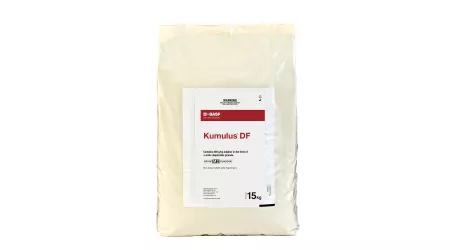Powdery mildew is a disease of many different crops. We use the same name across up to 10,000 plant species, but powdery mildew can be caused by as many as 700 different fungal pathogens. Host specification means many of these pathogens will only infect plants that are closely related.
The two fungi which cause powdery mildew in our squash and other cucurbit crops in New Zealand are Sphaerotheca fuliginea and Erysiphe cichoracearum. They are obligate biotrophic plant pathogens, which means they can only grow and reproduce on living host cells. So how do they keep reappearing on crops that can’t survive our winters? The answer is thought to be that their airborne spores travel long distances to create fresh infections in each year’s crops in conducive conditions.
Those conditions typically occur in warm weather in the middle of the growing season. While the powdery mildew pathogens can tolerate temperatures as low as 10°C, they grow most prolifically when the temperature is between 20° and 27°. As little as two hours of high humidity can create the ideal conditions for infection
as long as the plant leaves are relatively dry, which is more favourable for colonisation, sporulation and spore dispersal.
There’s no secret to being well prepared to repel the threat, explains BASF’s Senior Technical Services Specialist Tim Herman.
“Build an effective programme of preventive fungicide sprays around a reliable sulphur product,” he says. “Make sure to choose one which you’re confident about the quality, one reason BASF Kumulus® DF remains so popular.”
Tim says, from that point, it’s all about rotating other fungicides with different modes of action through the rest of the programme. “That way you’re managing both the immediate threat of infection and the long-term issue of developing fungicide resistance.”
There are three effective BASF fungicides which can help growers achieve both those aims.
“Colliss® might be the one squash growers know best because it’s been a mainstay for years,” Tim explains. “Its combination of Group 7 (SDHI) and Group 11 (QoI or strobilurin) chemistry attacks the pathogen at two sites in its lifecycle. It controls gummy stem blight as well as powdery mildew. The best timing for Colliss application in squash is early from the start of shoots running to early flowering.”
Tim notes that many growers now prefer to use Sercadis® instead of Colliss. Sercadis contains fluxapyroxad, which is a very efficient third generation SDHI fungicide. There’s a limit of two SDHI applications per crop for resistance management purposes, so each product can be used once per season or spray either Colliss or Sercadis twice.
Another effective powdery mildew control option is Vivando®, a Group 50 fungicide from BASF with a different mode of action, which is helpful in prolonging the usefulness of older fungicides.
“More and more squash growers are now getting great value from the reliable, sustainable performance of Vivando,” he explains. “It has both protectant and anti-sporulant action, boosted by a limited vapour phase that allows movement across the plant surface to increase its protective coverage.
“The big bonus is that using Vivando to extend the rotation also takes resistance pressure off the more common modes of action. When it comes to choosing fungicides, it’s a team effort. The more chemical groups you add to the mix, the more sustainable your success."




